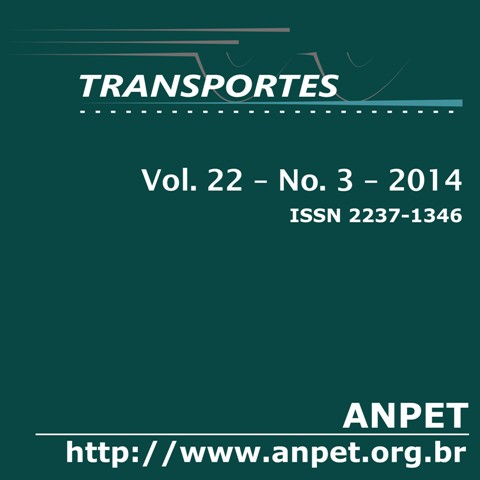Transferência de modelos de previsão de acidentes entre cidades brasileiras
DOI:
https://doi.org/10.14295/transportes.v22i3.790Keywords:
Accident Prediction Models. Transferability of APM. HSM. Traffic accidents.Abstract
Accident prediction models (APM) are expressions that relate the frequency of traffic accidents with road geometric and operational attributes and deal with relative success, with the high degree of randomness related to this phenomenon. The development of these models requires considerable efforts to obtain data on quantity and quality suitable for modeling. The use of models developed in other jurisdictions may be a less costly alternative than the development of specific models for each location. The objective of this study is to evaluate the transferability of APM for signalized intersections between cities. Models previously developed for Fortaleza and Belo Horizonte were calibrated and validated for the estimation of accidents in the city of Porto Alegre. The results indicated that the use of APM between jurisdictions is an alternative that should be used with caution, and it is desirable to invest efforts in developing specific models for each jurisdiction.
Downloads
References
AASHTO (2010) Highway Safety Manual. American Association of State Highway and Transportation Officials.1st. Edition, Washington, D.C.
Barbosa, H.M., F. Cunto, B. Bezerra, C. Nodari, M.A. Jacques (2013) Perspectives on the development of safety performance models for Brazilian roads. In: Pro-ceedings of the 13th World Congress on Transportation Research, Rio de Janeiro.
Claude, G. F. de M. (2012) Previsão da ocorrência de acidentes de trânsito em interseções de vias arteriais urbanas – O caso de Taguatinga/DF. Dissertação Mes-trado. Programa de Pós-Graduação em Transportes, Universidade de Brasília.
Costa, T.G., H.M. Barbosa (2011) Modelos de Previsão de Acidentes de Trânsito em Vias Urbanas de Belo Horizonte. Anais do XXV ANPET - Congresso de Pesquisa e Ensino em Transportes, Belo Horizonte, p. 1-10.
Cunto, F.J.C., M.M. Castro Neto, D.S. Barreira (2012) Modelos de previsão de acidentes de trânsito em inter-seções semaforizadas de Fortaleza. Transportes, v.20, n.2, p.57–64. DOI:10.4237/transportes.v20i2.558.
Cunto, F.J.C. (2008) Assessing Safety Performance of Transportation Systems using Microscopic Simulation Tese de Doutoramento, Department of Civil and Envi-ronmental Engineering, Universidade de Waterloo, Ontário.
Hauer, E. (1997) Observational Before-After Studies in Road Safety. Pergamon Press, Elsevier Science Ltd., Oxford, England.
Holz, R.F., Medeiros, F.S., Lange, R.L., Nodari, C.T., Lindau, L.A. (2012) Volume Diário Médio Anual (VDMA): Questões Conceituais e Cálculo de Fatores de Expan-são. Anais do XXV ANPET - Congresso de Pesquisa e
Ensino em Transportes, Joinville, SC.
Sacchi, E., Persaud, B, Bassani, M. (2012) Assessing International Transferability of Highway Safety Manual Crash Prediction Algorithm and Its Components. Trans-portation Research Record: Journal of the Transportation Research Board, No. 2279, Transportation Research
Board of the National Academies, Washington, D.C., pp. 90–98. DOI: 10.3141/2279-11
Sawalha, Z. e T. Sayed (2006) Traffic accident modeling: some statistical issues. Canadian Journal of Civil Engineering.v.33, p. 1115-1124. DOI: 10.1139/l06-056
Sun, X., Li, Y., Magri, D., Shirazi, H. (2006) Application of Highway Safety Manual Draft Chapter: Louisiana Experience. Transportation Research Record: Journal of the Transportation Research Board, No. 2080, Transportation Research Board of the National Academies, Washington, D.C., p 55–64. DOI:10.3141/1950-07
Vogt, A., J. Bared (1998) Accident models for two-lane rural segments and intersections. Transportation Re-search Record: Journal of the Transportation Research Board, No. 1635, Transportation Research Board of the National Academies, Washington, D.C., p. 18-29. DOI: 10.3141/1635-03
Xie, F., Gladhill, K., Dixon, K. K., Monsere, C.M. (2011) Calibrating the Highway Safety Manual Predictive Models for Oregon State Highways. Transportation Research Record: Journal of the Transportation Research Board, No. 2241, Transportation Research Board of the National Academies, Washington, D.C., 2011. pp 19-28. DOI: 10.3141/2241-03
Downloads
Published
How to Cite
Issue
Section
License
Authors who submit papers for publication by TRANSPORTES agree to the following terms:
- The authors retain the copyright and grant Transportes the right of first publication of the manuscript, without any financial charge, and waive any other remuneration for its publication by ANPET.
- Upon publication by Transportes, the manuscript is automatically licensed under the Creative Commons License CC BY 4.0 license. This license permits the work to be shared with proper attribution to the authors and its original publication in this journal.
- Authors are authorized to enter into additional separate contracts for the non-exclusive distribution of the version of the manuscript published in this journal (e.g., publishing in an institutional repository or as a book chapter), with recognition of the initial publication in this journal, provided that such a contract does not imply an endorsement of the content of the manuscript or the new medium by ANPET.
- Authors are permitted and encouraged to publish and distribute their work online (e.g., in institutional repositories or on their personal websites) after the editorial process is complete. As Transportes provides open access to all published issues, authors are encouraged to use links to the DOI of their article in these cases.
- Authors guarantee that they have obtained the necessary authorization from their employers for the transfer of rights under this agreement, if these employers hold any copyright over the manuscript. Additionally, authors assume all responsibility for any copyright infringements by these employers, releasing ANPET and Transportes from any responsibility in this regard.
- Authors assume full responsibility for the content of the manuscript, including the necessary and appropriate authorizations for the disclosure of collected data and obtained results, releasing ANPET and Transportes from any responsibility in this regard.









